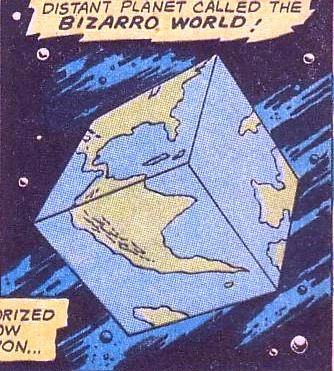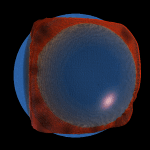Cube planet scaled one in sixty million

This is a simulation of how would the water and other fluids distribute on a cube of the same volume and density as Earth. The simulation and modelling was made using MATLAB R2016a.
The file's names explained: name_1_x_10_y.stl is 1 : x * 10y. So _1_6_10_7 is 1:600000000 or one in 60 million.
I spend part of my time making these models, letting them available and free for everyone. If you want to support my work, you can contribute with me here:
The file's names explained: name_1_x_10_y.stl is 1 : x * 10y. So _1_6_10_7 is 1:600000000 or one in 60 million.
Cube planets
There are several cube shaped planet in fictional literature. Most of them are present in a satirical way, as opposite of the classical spherical planet. In this model of planet the contour of continents and oceans are drawn all across every face of the cube, edge to edge. Some example of this are Aocicinori, and Htrae, a parody of an opposite Earth in DC universe. These cubic planets have a simple fault, that is the water and gases would "fall" to the center of mass, that is not necessary normal to the face surface. If you were near the edge of a face of the cube, you would feel the attraction of gravity toward the center of the face, not normal to the ground, like if you were in the side of a mountain. Walking to the edge would be like climbing the mountain. This leds us to the other model, that is one of the possible planets you can find randomly on the game Spore. In those planets the water form a sphere around the center of mass, like a sphere overlapping the cube. This model is not entirely true, because the gravity force in any place of the cube surface is not homogeneous. To get the right model I decided to simulate the gravity attraction around a cube of the same volume and density as Earth. To simulate the sea level I assume that the sea level only depends on the air pressure, and therefore, only dependant on the gravity vector value. Once you go far from the floor, the gravity force became weaker. The algorithm calculate for every spherical coordinate the height off the floor when it reaches a reference value of gravity acceleration. If the gravity is too low at the surface it means that is too high to be the ocean surface. The result is something between the two models, with a nearly spherical surface, but flattened compared with the Spore model. Of course this results are assuming a homogeneous density, and a non deformable cube, if the mass were concentrated in the nucleus, the results would be closer to the last model. |  |
| Bizarro world | Cube planet from Spore |
Environment
Lets assume that this kind of planet exists, its shape is nearly rigid, and it orbits a Sun like star at the right distance to have Earth like conditions, the environment would be quiet different from ours. Near the coastline, where the air pressure and gravity are similar to those of Earth, the climate would be pleasant, but moving toward the "edge" of a "face" of the cube, the air pressure drops drastically. A few kilometres more in that direction and the climate would be top mountain like, with snow covering the floor wherever the latitude. If there were rivers, they would ran radially straight to the ocean. If you keep going to the edge the atmosphere would became so tenuous that no snow could reach there. In the edge regions there would only be crude rock exposed to the vacuum, leaving the surface vulnerable to the impact of any small asteroid. Impact craters in this regions could not be eroded by the atmosphere. The giant oceans would also be hostile to life. Again, near the coastline everything would be fine, but leaving it the oceans became kilometres deep. At the bottom the pressure would be so high that water cannot be liquid. This would form an ice layer that would prevents the interchange of nutrients and minerals with the rocky crust. Offshore, the oceans would be sterile aside for the influence of the coasts.References
I spend part of my time making these models, letting them available and free for everyone. If you want to support my work, you can contribute with me here:




































































































































